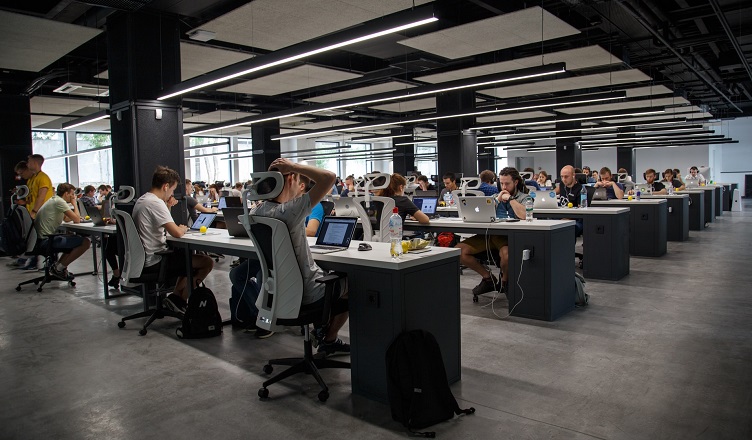Unlike what most employers believe, there is no much hassle in hiring non-immigrant international students in their organization. These students come either on F-1 or J-1 visas and most of them are authorized to work under CPT, OPT, or AT. Thus, there is no legal hindrance to hiring them.
The procedure adopted for introducing them into acquiring authorization for working in US firms is long existent and firmly established, thereby helping them to mingle easily into the workspace. Furthermore, these procedures are overseen by Visa and Immigration Services (VIS) or the United States Citizenship and Immigration Services (USCIS).
Before understanding the basic guidelines for hiring international students, let us take a look into the benefits that international student brings to a work environment:
- International students help in diversifying your workspace and provide ease in syncing your work environment on a global scale.
- Bringing international students into your fold helps in bringing fresh thinking processes and better solutions to your concerns.
- The different cultural practices especially business ideologies will help to bring out solutions that are a class apart.
- With the top-notch quality of skills presented alongside an ability to adapt to situations, international students will become part of the reason for improving work standards.
Knowing all the benefits coming from hiring international students, let us now indulge in the Employer’s guide to hiring international students.
As said earlier, international students are allowed to work under OPT, CPT, AT, or H-1B on the basis of the visa status they hold. Let us look at it one by one:
1. Curriculum Practical Training (CPT) :
It is an authorization provided to international students under F-1 visa status, allowing them to undertake employment that is related to their major area of concern as per their academic curriculum.
The major role of the employer here will be the provision of an offer letter alongside job specifications describing the exact nature of work, important dates related to employment, number of working hours on a weekly basis, the address of the place of employment, and the supervisor in charge.
Hereafter, the student has to look into submitting the request form through access, alongside the submission of the above-mentioned offer letter. It is important to note that for a student to apply for full-time/Part-time CPT jobs, he/she must simultaneously be a part of the academic curriculum.
The entire job duration must consider the academic dates and must be provided accordingly. Typically, CPT jobs are provided on a part-time basis during semesters and on a full-time basis during summer and winter breaks. A job is considered to be part-time if covers less than or equal to 20 hours a week, if it is more than or equal to 21 hours a week, it is considered a full-time job.
Concerning cost, neither the employer nor the student has to pay any kind of charges. The time taken to process the approval will be somewhere between 5 – 10 days.
Employers must take note of the dates mentioned in the I-20 form. In no way, should the students be permitted to work before the date of starting mentioned neither should they be allowed to work beyond the end date. Provided the student is eligible, the CPT permit may be extended.
2. Optional Practical Training (OPT)
Under OPT, international students are entitled to attain practical knowledge and consolidate experience in jobs that directly correspond to their concerned area of study.
Unlike CPT, it is purely students’ responsibility to look into applying for OPT. Here, the employer has no role as authorizing for OPT doesn’t require an offer letter.
There are two steps for applying to OPT authorization. Firstly, Students need to place an e-request at accessVIS where an international student advisor mediates to process it. Thereafter, the student forwards their filled up I-765 application alongside the processing fees and I-20 form raised by VIS to USCIS, requesting for OPT work permit.
Students who receive OPT work permit are authorized to work for 12 months as per rules. The further extension for these work permits can only be done if the concerned area of study is enlisted in STEM.
Similar to CPT, OPT authorization does not need the employers to pay anything. The students must take care that they apply 90 days ahead of their graduation as USCIS takes about 3-5 months to process the authorization.
After the processing, the students will receive an Employment Authorization Document (EAD) card. Students should see to it that they don’t start working before they receive the EAD card and the starting date mentioned in EAD.
3. STEM Extension
This extension is provided to students who are authorized to work under OPT work permit for F-1 visa holders, specifically the students majoring in the categories of Science, Technology, Engineering, and Maths (STEM).
For this extension, the employer has to help the students fill up the I-983 form, specifically sections 3 to 6 which is concerned with certain details about the company, the practical training schedule adopted, and compensation provided alongside the formal training plan. STEM extension also needs a self-progress evaluation by the candidate and attested by the employer for its accuracy.
The students who fall under this category will be eligible to claim 24 months of working extension.
Here too, the employer doesn’t need to pay for any processing. As USCIS takes about 3 – 5 months for processing, students are advised to apply at least 90 days before their standard OPT work permit expires.
The student who requested for STEM extension will receive the EAD card. The student has to follow the dates given on the EAD card which specifies the starting dates. The extension period begins from the day after the standard OPT permit expires. Students must note that If I-765 remains pending as of the starting date of STEM extension, then they are authorized to only 180 days of working after their standard OPT work permit expires.
4. Academic Training (AT)
This is a work authorization given to international students holding J-1 visa status. It can be issued either before or after graduation, allowing the students to work in the sector of their majors. AT work is considered full-time work even if the employment is part-time.
The major role of the employer here will be the provision of an offer letter alongside job specifications describing the exact nature of work, important dates related to employment, number of working hours weekly, the address of the place of employment, and the supervisor in charge.
Hereafter, the student has to look into submitting the request form through access, alongside the submission of the above-mentioned offer letter.
Students enrolled in bachelor’s or master’s programs are eligible for 18 months of AT. Whereas students enrolled in Ph.D. are eligible for 36 months of AT. The students who are part of an exchange program are eligible for AT work permit of duration as per their duration of studies in the U.S.
It doesn’t require any processing fees on the part of the employer or student. The processing takes around 5-10 working days.
A permit letter and a new DS -2019 letter to cover any status extensions if applicable. All the information pertaining to a student’s activity, location, and period of their stipulated academic training will be logged in to SEVIS, though may not be seen on the updated DS-2019.
5. H-1B
This work permit is filled in by the company sponsoring an international employee at USCIS. H-1B visas are limited to 65,000 for students who have completed their graduation while 20,000 visas are kept for those who did their graduation in the U.S.
For this Visa application, the employer has to apply at the behest of the international student. H-1B can be renewed for up to 6 years.
Due to the specific number of H-1B visas permitted each year, the employer must apply at the earliest. The application must reach USCIS by April 1st or soon afterward as the H-1B visa is in high demand. The approved visa is put into effect starting October 1st.
There are some special cases for the provision of H-1B visas for some organizations beyond the cap of 85000. Because of a treaty with the USA, Citizens of Chile and Singapore are specifically allocated 6800 H-1B visas which help the people from these places to get hold of an H-1B work permit comparatively more easily.
The companies hiring international students must see to it that all the formalities are fulfilled and satisfied as per the norms to be free of any hassling issues in legalities thereafter.
Employing international students at your workplace will make your working environment more thriving and culturally rich. This helps in improving the productivity of all the employees under you, thus, in turn benefitting your firm in the long run.
- Why Campus Recruitment Strategy Is Important For Your Business? - March 1, 2023
- New Employee Onboarding Process: Checklist and Tips - February 28, 2023
- Innovative Employee Retention Strategies for Retaining Top Talent - February 27, 2023



